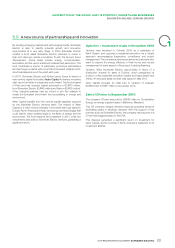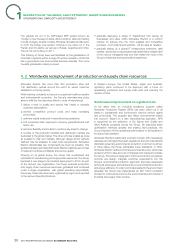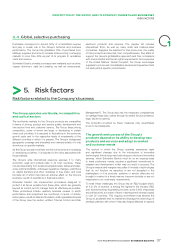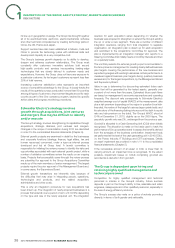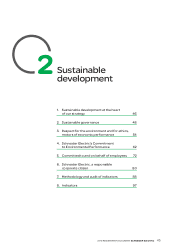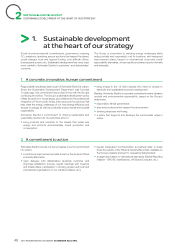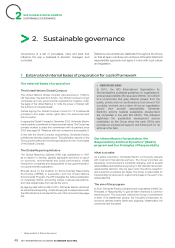APC 2010 Annual Report Download - page 40
Download and view the complete annual report
Please find page 40 of the 2010 APC annual report below. You can navigate through the pages in the report by either clicking on the pages listed below, or by using the keyword search tool below to find specific information within the annual report.
DESCRIPTION OFTHEGROUP, ANDITSSTRATEGY, MARKETS ANDBUSINESSES
1RISK FACTORS
its line up or geographic coverage. The Group has brought together
all of its electrotechnical, electronic, electromechanical, software
and other technical competencies by creating technology parks in
China, the US, France and Japan.
Support centres have also been established in Mexico, India and
China to provide the technology parks with additional skills and
development capacity at a very competitive cost.
The Group’s business growth depends on its ability to develop,
deepen and enhance customer relationships. The Group must
constantly offer customers innovative solutions built around
high-quality products and services incorporating leading-edge
technologies that are closely tailored to customer needs and
expectations. However, the Group does not have any exposure to
a particular customer. Its ten largest customers represent less than
25% of total revenue.
Increasing customer satisfaction rates represents an important
source of competitive advantage for the Group. It closely tracks the
results of the quarterly surveys conducted in more than 80 countries
among all types of customers. Improvement targets are set for each
country as part of the One company program, backed by specifi c
action plans and progress monitoring procedures.
Schneider Electric’s strategy involves
growth through acquisitions, joint ventures
andmergers that may be difficult to identify
and/or execute
The Group’s strategy involves strengthening its capabilities through
acquisitions, strategic alliances, joint ventures and mergers.
Changes in the scope of consolidation during 2010 are described
in note2 to the consolidated fi nancial statements (Chapter 5).
External growth projects are examined in detail by the businesses
and corporate functions (strategy, fi nance, legal affairs, tax and
human resources) concerned, under a rigorous internal process
developed and led at Group level. A launch committee is
responsible for initiating the review process to identify the risks and
opportunities associated with each external growth project, while a
number of validation committees review the results on an ongoing
basis. Projects that successfully come through the review process
are submitted for approval to the Group Acquisitions Committee
made up of the main members of senior management. The largest
projects require the prior approval of the Management Board and,
in some cases, the Supervisory Board.
External growth transactions are inherently risky because of
the diffi culties that may arise in integrating people, operations,
technologies and products, and the related acquisition,
administrative and other costs.
This is why an integration procedure for new acquisitions has
been drawn up. The integration of newly acquired businesses is a
process that extends over a period of six to 24months depending
on the type and size of the newly acquired unit. The integration
scenario for each acquisition varies depending on whether the
business was acquired to strengthen or extend the Group’s existing
line up or enter a new segment. There are a number of different
integration scenarios, ranging from total integration to separate
organisation. An integration plan is drawn up for each acquisition
and submitted to the Acquisitions Committee for approval. The
plan is implemented by an integration manager who reports to a
Steering Committee that initially meets at monthly intervals and then
on a quarterly basis.
The unit that presents the external growth project is accountable to
the Group’s senior management for meeting clearly defi ned business
plan targets covering the performance of the new business and
expected synergies with existing businesses. Actual performance is
measured against business plan targets during quarterly business
reviews and, for the largest acquisitions, by the Management Board
and Supervisory Board.
Value in use is determined by discounting estimated future cash
fl ows that will be generated by the tested assets, generally over
a period of not more than fi ve years. Estimated future cash fl ows
are based on management’s economic assumptions and operating
forecasts. The discount rate corresponds to Schneider Electric’s
weighted average cost of capital (WACC) at the measurement date
plus a risk premium depending on the region in question (local risk-
free rate), the nature of the target’s business (appropriate beta), and
the structure of the fi nancing (taking into account the debt to equity
ratio and risk premium on the debt). The Group’s WACC stood at
8.4% at December31, 2010, slightly up on the 2009 fi gure. The
perpetuity growth rate was 2%, unchanged from the previous year.
Goodwill is allocated to a Cash Generating Unit (CGU) when initially
recognised. The allocation is made on the basis used to track the
performance of Group operations and to assess the benefi ts derived
from the synergies of the business combination. Impairment tests
are performed at the level of the cash generating unit in 2010 (CGU),
i.e. the Power, Industry, IT Buildings and CST businesses. Details
on asset impairment are provided in note1.11 to the consolidated
fi nancial statements (Chapter 5).
If the recoverable amount of an asset or CGU is lower than its
carrying amount, an impairment loss is recognised. To the extent
possible, impairment losses on CGUs comprising goodwill are
recorded as a deduction from goodwill.
The Group is dependent upon hiring and
retaining highly qualified management and
technical personnel
Competition for highly qualifi ed management and technical
personnel is intense in the Group’s industry. Future success
depends in part on the Group’s ability to hire, assimilate and retain
engineers, salespeople and other qualifi ed personnel, especially in
the area of energy effi ciency solutions.
The Group’s success also rests on a policy of actively promoting
diversity, in terms of both gender and nationality.
2010 REGISTRATION DOCUMENT SCHNEIDER ELECTRIC38







